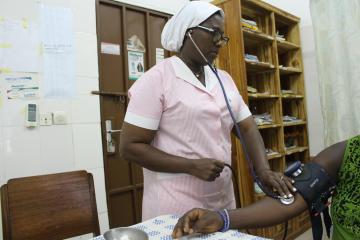Revenue cycle management is a great place for operational improvement technologies. These technologies can leverage process and task mining to give leaders a bird’s-eye view of their teams’ workflows.
But according to 20-year healthcare veteran Todd Doze, CEO of Janus Health, a revenue cycle management technology company, there are three common myths associated with operational improvement technologies:
- Operational improvement systems replace human touch – even though they’re designed to help humans make better decisions.
- Operational improvement technologies lack the granularity needed to make decisions – even though they provide a granular view at the workflow level that the human eye cannot comprehend.
- Operational improvement systems require time a team does not have – even though many organizations find these technologies help reallocate staff in a low-risk, high-reward way that enables team members to work at the top of their license.
Healthcare IT News sat down with tech CEO Doze for a deep dive into these myths he describes and the realities, according to him and his experience with the technologies, that he would like more people to comprehend.
Q. You say there are three common myths associated with operational improvement technology. Let’s get to the bottom of them. Your first myth: Operational improvement systems replace the human touch. Please elaborate on why this is not true, in your eyes.
A. To fully unpack this, let’s start by outlining what operational improvement technology is. At its core, this technology is designed to aid organizations in receiving maximum return with the least amount of effort.
It’s no secret hospitals are understaffed, and not just on the clinician side. Back-end billing offices also deal with staff shortages and limited hours in the day to process, follow up and collect on claims that inundate their system. These challenges combined with a difficult payer mix can make workflows extremely laborious and inefficient, resulting in delays. The most critical delay being late payments, which directly affect a hospital or health system’s bottom line.
The idea that operational improvement technologies will eliminate human connection is simply not justified. In reality, the goal of this technology is to leverage process and task mining to help humans make better decisions – not replace them.
One third of excessive spending in healthcare today is spent on administrative tasks, and the billing/revenue cycle folks are no stranger to this dilemma. Operational improvement technology, oftentimes with the help of automation but not always, can provide data and context clues to help teams make the next right decision.
Sometimes that decision is knowing what and where to automate, and other times it’s realizing process refinement and retraining of staff is needed to carry on. Change management is possible thanks to tools like this, as it directly gets to the root of “how your people are working” and “what your people are working on.”
It’s up to you and your leadership team what to do with those answers – deciding how and what to optimize.
Q. Your second myth: Operational improvement technologies lack the granularity needed to make decisions. Why a myth?
A. As much as humans like to believe we can capture everything (and that nothing will get past us), the truth is we all make mistakes in some shape or form. An example: For many years, health systems have relied on internal process improvement teams or third-party consultants to examine workflows and identify areas that need improvement.
Despite their best efforts, human observation of other humans at work is the equivalent of looking through a limited lens. There are many reasons for this, the biggest being that individuals act different when being monitored. This hurts the understanding of the overall workflow, which ultimately leads to the hindrance of optimization efforts.
The idea operational improvement systems can offer a granular view of the workflows human eyes can’t comprehend should be music to the ears of revenue cycle professionals. Thanks to the ability to zero in on the individual daily workflows at the team, payer or individual level, cracks in the foundation can be quickly identified and teams are better equipped to course-correct as needed.
For example, maybe there’s a certain individual who is struggling to make inroads on claim resolutions. There could be a multitude of reasons for this, including but not limited to a difficult payer mix, too many steps needed, not enough steps being taken, so on and so forth.
The beauty of capturing these issues early will lead to a multitude of positive outcomes for the health system or hospital, including: fewer inefficiencies leading to better performance, identification of processes broken or no longer serving the organization, analysis of quality gaps expensive from a time and financial standpoint to maintain, and, last but not least, denials prevention.
Q. And finally, your third myth: Operational improvement systems require time a team doesn’t have. They don’t?
A. There’s no doubt reviewing data that operational improvement technology can provide will take time and effort – like anything worth doing, there’s an investment required. However, I can say very confidently that chances are this time pales in comparison to the time your team is wasting on inefficient, outdated workflows.
If you’ve ever thought to yourself, Isn’t there a better way to widen our margins, or, What are my teams really working on? Then operational improvement technology is worth a conversation.
In a recent report from the AHA, it was discovered labor makes up the biggest percentage of hospital expenses. That’s a whopping $893 billion spent on labor, which far surpasses other expenses such as drugs and supplies.
Operational improvement technology offers a low-risk, high-reward way to make sure your workforce is operating at the top of their license. We all know the challenges that come from managing hourly workers, and it’s even more challenging when we don’t have a clear picture of how they’re spending their time.
Operational improvement technology takes the guesswork out of it and provides a level of security that leaders need to manage their teams well.
Knowledge is power. Leaders owe it to themselves and their teams to have the proper data required to make decisions that are in everyone’s best interest. The sooner you can dive into that data and make decisions, the sooner you will free up more time – ultimately creating more margin at the enterprise level.
Follow Bill’s HIT coverage on LinkedIn: Bill Siwicki
Email him: bsiwicki@himss.org
Healthcare IT News is a HIMSS Media publication.
Note: This article have been indexed to our site. We do not claim legitimacy, ownership or copyright of any of the content above. To see the article at original source Click Here













